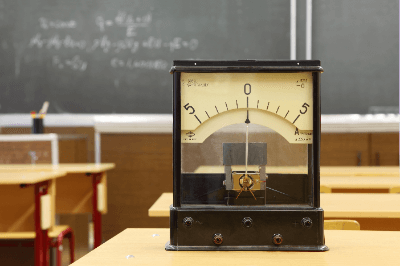What Is a Galvanometer?

A galvanometer is a device designed for measuring electric current. In its simplest form, a galvanometer measures current by clamping onto a cable. The output display can be either analog or digital.
Galvanometers come in a wide range of current measurement capabilities, spanning from milliamperes to several amperes. They find applications in various fields, including manufacturing, where they are used to measure very small currents such as microamperes.
Uses of Galvanometers
Galvanometers are essential for detecting electric currents in electrical and electronic components.
Simple galvanometers are commonly used for equipment maintenance and product inspection due to their compact, lightweight, and portable nature. They are employed to measure currents in circuits where a permanent current indicator is not installed. Additionally, they are often utilized in elementary school science experiments due to their ease of use and cost-effectiveness.
In industrial settings, where current is a fundamental physical quantity, galvanometers play a crucial role in product development and quality control, particularly in industries such as semiconductors and functional materials. Specialized galvanometers, known as electrometers, are used for measuring extremely small currents, even in the nanoampere range, especially in information equipment.
Principle of Galvanometers
A typical galvanometer comprises a movable coil, a permanent magnet, a pointer, and a coiled spring.
The movable coil is situated within a permanent magnet, which generates a magnetic field. The pointer moves in coordination with the movable coil. When an electric current flows through the coil, the pointer’s position corresponds to the current’s magnitude, providing a current reading. When the current ceases, the coiled spring returns the pointer to the zero position.
Other Information on Galvanometers
1. Precautions When Using Galvanometers
Galvanometers have current limits, and exceeding these limits can lead to damage or disconnection of the movable coil. The allowable current value is specific to each galvanometer and should be checked before measurements. Excessive current can also generate Joule heat, potentially causing coil damage. For precise measurements of tiny currents, consider using devices like electrometers to ensure accuracy.
2. Difference Between Galvanometer and Ammeter
Both galvanometers and ammeters are instruments for measuring current, but galvanometers are a type of ammeter. Galvanometers are used for detecting minute current values and determining current direction. Ammeters, on the other hand, quantitatively measure current values and are typically employed for measuring larger currents. Unlike galvanometers, ammeters do not provide information about the current direction.
3. Prohibited Use of Galvanometers
It is strictly prohibited to connect a power supply directly to a galvanometer. Galvanometers have very low internal resistance, and a direct connection to a power supply can damage the movable coil. Therefore, when connecting a galvanometer to a power source, always use it in conjunction with an electrical resistance.
4. Symbol of Galvanometer
In electrical circuit diagrams, ammeters are represented by the symbol “A,” voltmeters by “V,” and galvanometers by “G.” Galvanometers are denoted by the letter “G” in honor of the Italian physicist Luigi Galvani, from whom the name “galvanometer” is derived.